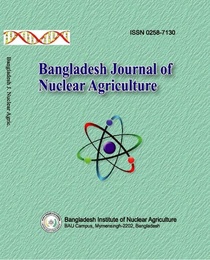IN VITRO CALLUS REGENERATION OF BRASSICA SPP THROUGH ANTHER CULTURE (Short Communication)
Abstract
Brassica is an important oil-yielding crop under Brassicaceae family. Brassica is the third most important vegetable oil crop in the world, after palm and soyabean oil. But it takes a long time to develop new Brassica cultivars. Haploid production of Brassica spp. through anther culture proved to be an important approach of tissue culture. The purpose of this study was to carry out a suitable protocol for happloid production of Brassica spp. and observe genotypic variation for callus induction. Three replications were used containing different concentration of 2, 4-D, BAP, Kiniten and NAA. The highest percentage of callus induction (56.2%) was found in CM 800 within minimum days (18 days) and the nature of callus was compact. It indicates totipotency capacity of cell was also influenced by radiation. Future study was necessary to shoot and root induction process for successful speed breeding program.
References
Alam, M.A., Haque, M.A., Hossain, M.R., Sarker, S.C., and Afroz, R. 2009. Haploid plantlet regeneration through anther culture in oilseed Brassica species. Bangladesh J. Agril. Res. 34(4) : 693-703.
Ali, J., Katrina, L.C., Nicolas, Akther, S.,Torabi, A., Ali, A., Ebadi, Corinne, M., Nazarea, M. and Mahender, A. 2021. Improved Anther Culture Media for Enhanced Callus Formation and Plant Regeneration in Rice (Oryza sativa L.). Plants 10 (5): 839.
Asif, M. 2013. Progress and Opportunities of Doubled Haploid Production. Cham: Springer International Publishing. 6:7-44.
Cardoza, V. and Stewart, C. 2006. Agrobacterium Protocols 343: 257-266.
Forster, B.P., Till, B.J., Ghanim, A.M.A., Huynh, H.O.A. 2014. Accelerated plant breeding. CAB Rev. 9:3-15.
Javed, M.A. and Hassan, S. 1992. Callusing and regeneration response of cotyledon explants of some rapeseed genotypes. Sarhad J. Agriculture 8(3): 329-334.
Krishna, H., Alizadeh, M., Singh, D., Singh, U., Chauhan, N., Eftekhari, M. and Sadh, R. 2016. Somaclonal variations and their applications in horticultural crops improvement. Biotech. 6(1): 54.
Lenaerts, B., Collard, B.C.Y. and Demont, M. 2019. Review: Improving global food security through accelerated plant breeding. Pant Science.287:110207
Mishra, R. and Rao, G.J.N. 2016. In-vitro androgenesis in rice: advantages, constraints and future prospects, Rice Sci. 23: 57-68.
OECD/FAO (2012), OECD-FAO Agricultural Outlook 2012–2021, OECD Publishing and FAO. Available: http://dx.doi.org/10.1787/agr_outlook-2012-en
Razdan, M.K. 1993. An Introduction to Plant Tissue Culture, Oxford & IBH Publishing Co. Pvt. Ltd., New Delhi. pp. 118-122.
-
Download



